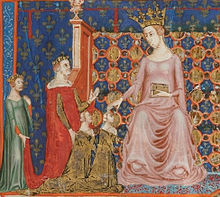Sancha of Majorca
| Sancia of Majorca | |
|---|---|

Queen Sancha from the Bible of Naples.
|
|
| Queen consort of Naples | |
| Tenure | 1309–1343 |
| Born | ca. 1285 |
| Died | 28 July 1345 (aged 60) Santa Maria della Croce Naples |
| Burial | Firstly Santa Maria della Croce, later Santa Chiara Basilica. |
| Spouse | Robert the Wise, King of Naples |
| House | House of Barcelona |
| Father | James II of Majorca |
| Mother | Esclaramunda of Foix |
Sancia of Majorca (c. 1285 – 28 July 1345), also known as Sancha, was by birth Infanta of Majorca and by marriage Queen consort of Naples. She served as regent of Napels during the minority of Joan II from 1343 until 1344.
She was the fifth child but second daughter of King James II of Majorca and Esclaramunda of Foix. The exact date of her birth is unknown, although the Chronicle of San Juan de la Peña placed her as the second daughter of the Majorca Royal couple: la primera....Isabel...la otra Sancha, and traditionally she is placed as the penultimate of the six children born from them.
In Perpignan on 17 June 1304 Sancha was married by proxy to Robert, Duke of Calabria and Prince of Salerno, the widower heir of the throne of Naples. The wedding in person took place three months later, on 20 September at the Chapelle des Hospitaliers at the Royal Palace of Collioure, Pyrénées-Orientales. The union was childless.
Sancha became Queen consort of Naples with the death of her father-in-law King Charles II of Naples on 5 May 1309. Two years later (2 August 1311) her husband gave her the Lordships of Potenza, Venosa, Lanciano, Alessa and Sant'Angelo dei Lombardi. The next year, on 24 March 1312, the testament of her mother Queen Esclaramunda (Sclarmunda...regina Majoricæ) secured a bequest to her (...Sanciæ..Reginæ Siciliæ...filiæ nostræ...). On 22 May 1319 at Marseille, Sancha and her husband prayed before the relics of his brother Saint Louis of Toulouse.
At her court in Naples, Sancha welcomed her brother Philip, who was recently joined the Franciscans. He wanted to practice strictly the Rules of Saint Francis of Assisi, and gathered around him a group that became known as "the brothers of poor life", a branch of Fraticelli or zelanti. This group was therefore a great influence over the King and Queen of Naples and over Delphine of Glandèves, Sancha's confident. Philip of Majorca asked his sister and his brother-in-law to intercede with the Avignon Papacy to obtain the privileges necessary for the transformation of the Santa Chiara monastery in a place where would welcome "the brothers of poor life". However, Pope Benedict XII ended their hopes with three bulls dated on 24 June 1336, 20 February 1337 and 7 August 1340.
...
Wikipedia
